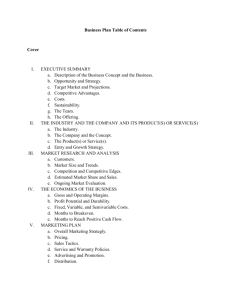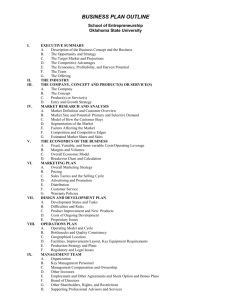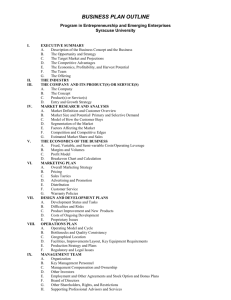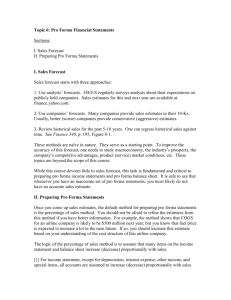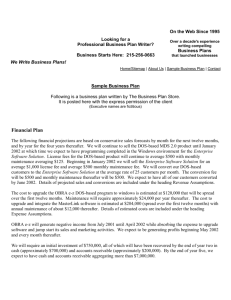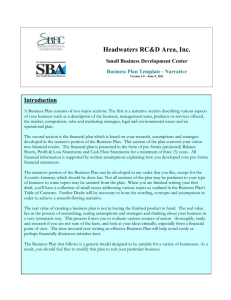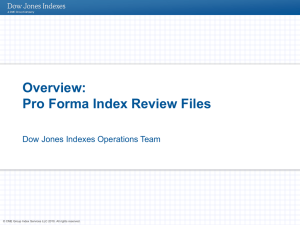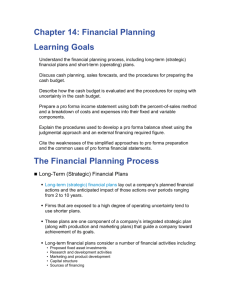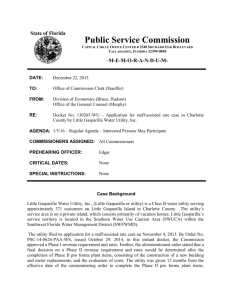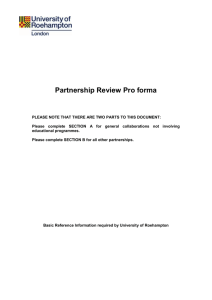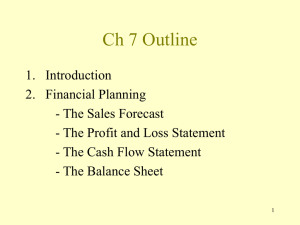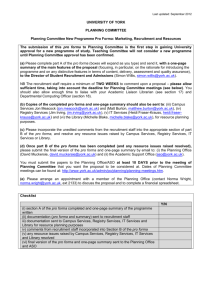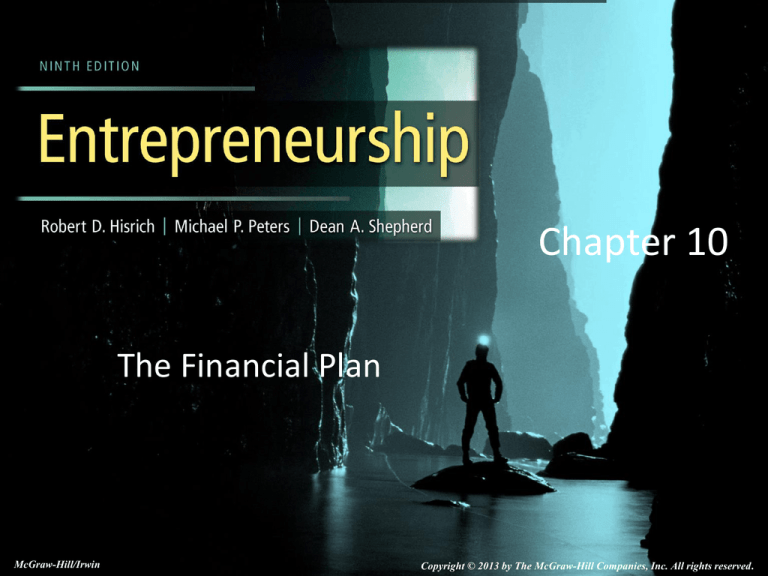
Chapter 10
The Financial Plan
McGraw-Hill/Irwin
Copyright © 2013 by The McGraw-Hill Companies, Inc. All rights reserved.
Learning Objectives
• To understand the role of budgets in preparing
pro forma statements
• To understand why positive profits can still
result in a negative cash flow
• To learn how to prepare monthly pro forma
cash flow, income, balance sheet, and sources
and applications of funds statements for the
first year of operation
10-2
Learning Objectives
• To explain the application and calculation of
the break-even point for the new venture
• To illustrate the alternative software packages
that can be used for preparing financial
statements
10-3
Operating and Capital Budgets
• Sales budget - An estimate of the expected
volume of sales by month
• Determined on the basis of sales forecasts
• Manufacturing ventures - Costs of internal
production and subcontracting are compared
• Includes ending inventory estimation
10-4
Table 10.1 - A Sample Manufacturing
Budget for First Three Months
10-5
Operating and Capital Budgets
• Operating costs
• Fixed expenses incurred regardless of sales
volume
• Variable expenses must be linked to strategy in
the business plan
• Capital budgets - Provide a basis for evaluating
expenditures
10-6
Table 10.2 - A Sample Operating Budget
for First Three Months ($000s)
10-7
Pro Forma Income Statements
• Pro forma income:
• Projects net profit calculated from projected
revenue minus projected costs and expenses.
• Starts by calculating monthly sales
• Projects operating expenses for each of the
months during the first year
• Projections should be made for years 2 and 3 as
well
10-8
Table 10.3 - MPP Plastics Inc., Pro Forma Income
Statement, First Year by Month ($000s)
10-9
Pro Forma Cash Flow
• Projected cash available calculated from
projected cash accumulations minus projected
cash disbursements
• Not the same as profit
• Sales may not be regarded as cash
• Profit as a measure of success may be deceiving if
there is significant negative cash flow
• Can be projected using the indirect or direct
method
10-10
Table 10.5 - Statement of Cash Flows:
The Indirect Method
10-11
Table 10.6 - MPP Plastics Inc., Pro Forma
Cash Flow, First Year by Month ($000s)
10-12
Pro Forma Balance Sheet
• Summarizes the projected assets, liabilities,
and net worth of the new venture
• Consists of:
• Assets
• Liabilities
• Owner’s equity: Amount invested and/or retained from
the venture operations
10-13
Table 10.7 - MPP Plastics Inc., Pro Forma
Balance Sheet, End of First Year ($000s)
10-14
Break-Even Analysis
• Breakeven: Volume of sales where the
venture neither makes a profit nor incurs a
loss
• The break-even formula
B/E(Q) = __________TFC______________
SP-VC/unit (marginal contribution)
• Weakness - Determining if a cost is a fixed or
variable
10-15
Table 10.8- Determining Break-Even
Formula
*Fixed costs are those costs that, without change in present productive capacity, are not affected by changes in volume of output.
† Variable costs are those that are affected in total by changes in volume of output.
‡ The variable costs per unit is all those costs attributable to producing one unit. This cost is constant within defined ranges of production.
10-16
Figure 10.1 - Graphic Illustration of
Breakeven
10-17
Pro Forma Sources and Applications
of Funds
• Summarize all the projected sources of funds
available and how these funds will be
disbursed
• Sources of funds
•
•
•
•
Operations
New investments
Long-term borrowing
Sale of assets
10-18
Pro Forma Sources and Applications
of Funds
• Uses
•
•
•
•
Increase assets
Retire long-term liabilities
Reduce owner or stockholders’ equity
Pay dividends
10-19
Software Packages
• Track financial data and generate financial
statements
• Present different scenarios and assess their
impact on the pro forma statements
10-20

